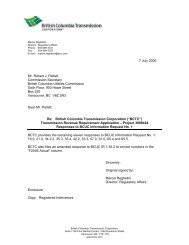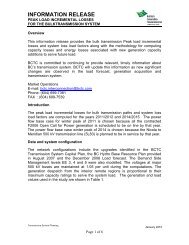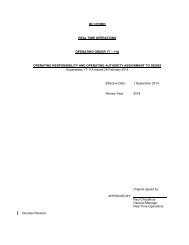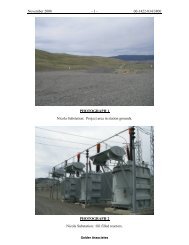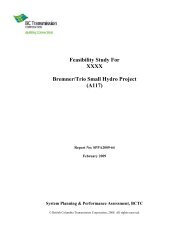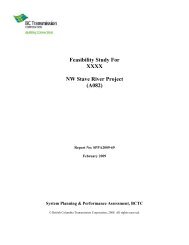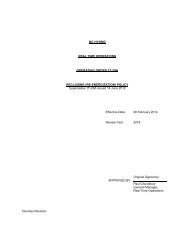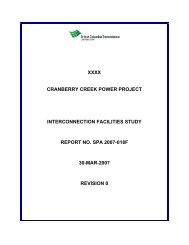Evidence on the Adequacy of First Nations Consultation - BC Hydro ...
Evidence on the Adequacy of First Nations Consultation - BC Hydro ...
Evidence on the Adequacy of First Nations Consultation - BC Hydro ...
Create successful ePaper yourself
Turn your PDF publications into a flip-book with our unique Google optimized e-Paper software.
DRAFT REPORT: Rights and Title Interests in <strong>the</strong> Columbia Valley Transmissi<strong>on</strong> Project Area<br />
Diam<strong>on</strong>d Jenness (1939) placed great reliance up<strong>on</strong> <strong>the</strong> comments <strong>of</strong> John McLeod, as cited<br />
above, who associated <strong>the</strong> Snare Indians with <strong>the</strong> Chinpoo [“Simpcw”], now recognized as <strong>the</strong><br />
North Thomps<strong>on</strong> Band <strong>of</strong> Shuswap. Ano<strong>the</strong>r scenario presented in Teit’s notes (1908-1920)<br />
proposes that <strong>the</strong> Snare were a group <strong>of</strong> Sekani Athapascan, separated from <strong>the</strong>ir nor<strong>the</strong>rn kin,<br />
who migrated first into Shuswap country and <strong>the</strong>n south until <strong>the</strong>y reached <strong>the</strong> upper Columbia<br />
and Kootenay valleys where <strong>the</strong>y were so<strong>on</strong> driven out by <strong>the</strong> Ktunaxa. After this time <strong>the</strong>y took<br />
refuge in <strong>the</strong> mountains.<br />
It is <strong>the</strong> positi<strong>on</strong> <strong>of</strong> <strong>the</strong> Shuswap Indian Band, as set out in <strong>the</strong>ir 2008 TUS report, and reiterated<br />
in <strong>the</strong> April 2009 report by Fish Lake C<strong>on</strong>sulting, that archaeological features present in <strong>the</strong><br />
Columbia Valley, specifically house pits (pithouse depressi<strong>on</strong>s), reveal an earlier occupati<strong>on</strong> <strong>of</strong><br />
<strong>the</strong> area by people who were immediate ancestors <strong>of</strong> those now identified as Interior Salish,<br />
which would include <strong>the</strong> Secwepemc. Hence, it is <strong>the</strong> Shuswap Nati<strong>on</strong> view that <strong>the</strong> any such<br />
features in <strong>the</strong> Columbia Valley would represent former Secwepemc winter sites, providing <strong>the</strong><br />
Shuswap Indian Band (and <strong>the</strong> larger Shuwsap Nati<strong>on</strong>) with a str<strong>on</strong>ger and more ancient claim to<br />
<strong>the</strong> territory.<br />
Without commenting <strong>on</strong> <strong>the</strong> veracity <strong>of</strong> this interpretati<strong>on</strong> <strong>of</strong> <strong>the</strong> archaeological evidence, this<br />
present report has not found evidence <strong>of</strong> <strong>the</strong>se semi-subterranean winter homes being used in <strong>the</strong><br />
Project area at <strong>the</strong> time <strong>of</strong> c<strong>on</strong>tact. The evidence indicates that <strong>the</strong> Kinbasket family entered <strong>the</strong><br />
area sometime between <strong>the</strong> 1820s and 1840s and likely settled prior to <strong>the</strong> 1850s.<br />
Bouchard & Kennedy Research C<strong>on</strong>sultants Page 81<br />
Page 84 <strong>of</strong> 200






